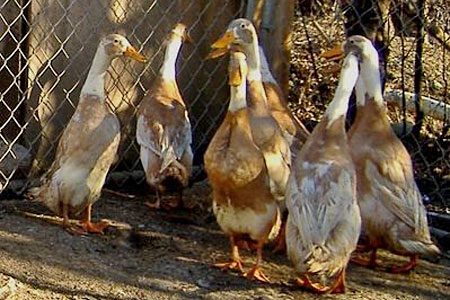
The Runner duck is an ancient breed known in the East Indies for at least 2,000 years. Its excellence lies in being a terrific layer that’s agile enough to easily herd over long distances.
Runner ducks were traditionally kept in pens overnight. After the hens laid their eggs in the morning, the ducks were herded to fields to clean up weed seeds, snails, and other undesirables.
Physical Attributes
The fawn and white Runner duck is by far the most popular of the numerous Runner duck color varieties. It has a tan cap, white neck, tan back, tan and white underbody, and white tail and wing tips.
Because its legs are farther back than those of most ducks, the Runner stands upright, like a penguin. Its bottle-like body is similar in shape to that of a wine bottle or a bowling pin.
Runner ducks are particularly active and always on the move. They don’t waddle like other ducks, but rather run from place to place, hence the name.
The Runner is a relatively small breed. Hens grows to 3¼ pounds, drakes to 4 or 4½ pounds. Because they are small, they eat somewhat less than other domestic duck breeds, making them super economical as layers.
Mature drakes differ from the hens in having curled tail feathers. Also the hens quack loudly, while the drake’s sound is barely audible.
Breed Qualities
Runner ducks mature in 4 to 5 months. The hens are good layers of medium-size eggs. Most Runner eggs have white shells, although some ducks lay eggs with bluish-green shells.
Runner hens have no strong instinct for brooding. And when they do brood, they lack a strong maternal instinct and therefore make rather poor mothers.
On average they lay between 100 and 180 eggs per year. Crossbreeding, along with greater emphasis on plumage color for exhibition, has resulted in reduced laying ability compared to early records.
Because of their small size, Runner ducks are not commonly considered to be a meat breed. However, the Runner is a better forager than any other domestic duck, giving the meat an excellent flavor similar to that of a wild duck. And their extreme agility, plus their inclination to not fly, makes them perfect for free ranging.
Fawn and white Runner ducks were admitted to the American Standard of Perfection in 1898. Thanks to their upright stance and alert demeanor, they show really well and remain popular at exhibition.
Runner ducks tend to be nervous, excitable, and easily startled. However, with early and frequent handling they readily become friendly as family pets. For a healthy, hardy duck that adapts well to any climate, consider the fawn and white Runner duck.
Helpful Links
- Keeping Ducks for Eggs
- How to Keep Your Ducks Laying Well
- How the Eggs of Chickens, Turkeys, Ducks and Geese Compare
- How to Handle Duck Eggs for Eating
And that’s today’s news from the Cackle Coop.
Gail Damerow is the author of An Absolute Beginner’s Guide to Raising Backyard Ducks : Breeds, Feeding, Housing and Care, Eggs and Meat.

